|
CANADIAN FORUM Column 5 By Robin Plewes |
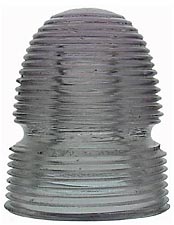 |
Canadian Porcelain Beehive Insulators
With this column I’ve been lucky enough to have a couple of submissions from other Canadian collectors. Manfred Hagar has shared his tale of the previously undocumented threadless porcelain beehive. Barrett Nicpon has written a show report for the First Annual South Western Ontario Swap and Show that was held June 5th.
Manfred writes:
Let me start be introducing myself, my name is Manfred Hager, and I've been collecting insulators since the late 70's. When I mentioned to Robin Plewes about finding a threadless Canadian porcelain insulator he suggested I share the story.
In early October 2002, I was reading an antiques magazine, which is available for free from just about any antique shop in southern Ontario. In the back of the magazine are sales and want ads, and one in particular caught my attention, offering to give away almost 30 years worth of Crown Jewels issues! I recognized the first 3 digits of the phone number as being for an area about a 2 hour drive away. I waited for a few days before calling and was surprised that no one else had called yet, and we arranged for a visit the following Saturday. I asked if the person had once collected insulators and the reply was yes, he had collected many years ago and had sold off the collection years ago, but thought there might be a few left in the basement.
We arrived early Saturday and were invited into the home to have a look at the magazines and were greeted with a pile of boxes 6 feet by 3 feet in volume! The Crown Jewels magazines were neatly packaged and immaculate and there were boxes of early 70's insulator related publications of all kinds. There were hard cover books, catalogs, Crossarm magazine issues, and Canadian Insulator Collector issues. The gentleman's wife told us that it was at her insistence that the ad was placed, as he felt that nobody would be interested in all of this material and was ready to throw it all out in the garbage! Nobody else had called to ask about the ad, and she said it was all ours to take. I wasn't comfortable just taking all of this material and after a bit of convincing I paid them $100 for the lot.* At this point the gentleman pointed to a small cardboard box sitting in the corner, which contained the few remaining insulators that he had found in his basement. Some newspaper packing was moved aside and the first 3 he pulled out were a tan coloured porcelain 143 style that we refer to as "dinosaur eggs". These he claimed were garbage and said I could have for free. There were 5 Dominion - 42's that I could see, 3 amber, 1 green, and another that looked kind of blue, and then I was handed 2 black glass 740 threadless insulators which I examined near a window with better light. One was a no-name and the second was a Foster Brothers. At this point, trying to remain calm, I asked if they were for sale and how much he was looking for. He quoted a price for the threadless which I felt was low and suggested a higher price more in line with their nearly mint condition. I was then offered the whole box for a price I couldn't refuse! He accepted my cheque and I made sure he had my name and telephone number should there be any problems.
After arriving back home I had a closer look at the "loot" and found a number of early Canadian Porcelain catalogs, which I invited my friend Paul Axman to come over for a look. Paul came for a visit during the week and was pretty sure that one catalog was the very first one published since it was made in a binder like fashion to easily add any additional pages. I showed Paul the 3 porcelain 143's and after a minute he hands one of them back to me and asked if I noticed anything unusual about it. I replied, "no",and after looking at it for some time, Paul suggested I put my thumb in the pinhole. It didn't take more than a few milli-seconds to realize it had no threads! It had never even crossed my mind to check the pinholes as the insulators were in clean condition.
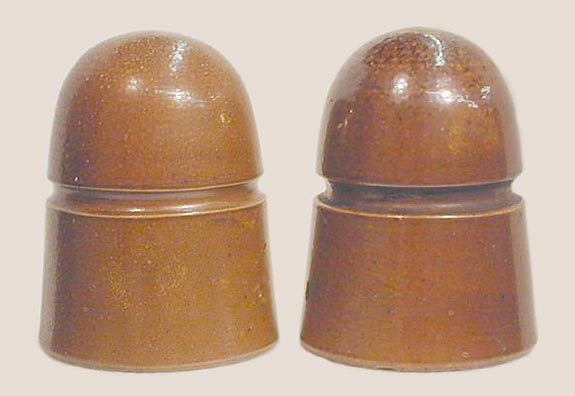
A side view comparison picture of a common
threaded beehive (Left)
next to the threadless version (Right ).
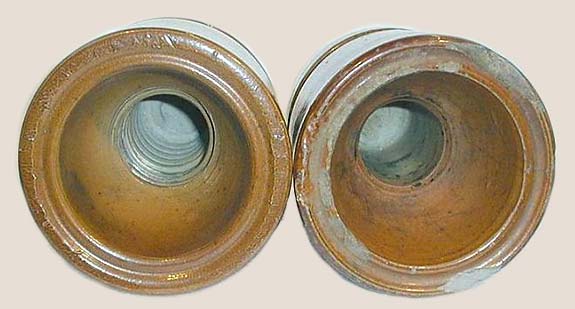
A bottom view comparison picture of a common
threaded beehive (Left)
next to the threadless version (Right)
The pinhole is typical of threadless glass
insulators, measuring 1" across at the opening and tapering down to 15/16" at
the top of the pinhole. Dave French and Rick Soller had traveled in for the week
to attend an insulator show, which took place at the home of Bruce Templeton
that fall. Both Rick and Dave also examined the insulator and we decided that
since the pinhole opening had been partially glazed over that it had been made
"threadless". I don't know any details of early porcelain insulator
manufacturing and can only speculate that a step in the manufacturing process
was missed, or it was made without threading on purpose. I have personally dug
up these porcelain 143 style pieces on a number of early southern Ontario
railway lines, which were built pre 1880. Some shards were even located at pole
sites where threadless and threaded glass shards were also found, so indications
are it was of an early manufacture. Another collector, Phil Ort is convinced
that these were of British origin as they have the same glaze colouring as the
threadless porcelain shards he dug up as reported in a Crown Jewels article from
November 1992.
Once again it pays to follow those leads and be prepared for those "unexpected"
surprises.
Manfred
Another closely related insulator worth mentioning here is the “dinosaur egg” with the CNR marked on the dome. These insulators are not common and have only been found in a few locations. As the coloring is very similar, I expect they were made by the same manufacturer as the more common unembossed threaded insulators. One outstanding feature of these CNR beehives is that the threads are not continuous. This is to say that they are essentially rings rather than threads. This can be seen in the picture. The rings must have been hand made with a comb-like tool after the insulator was formed and before it was fired. The examples I’ve seen have different amounts of glazing, which again indicates a hand made insulator.
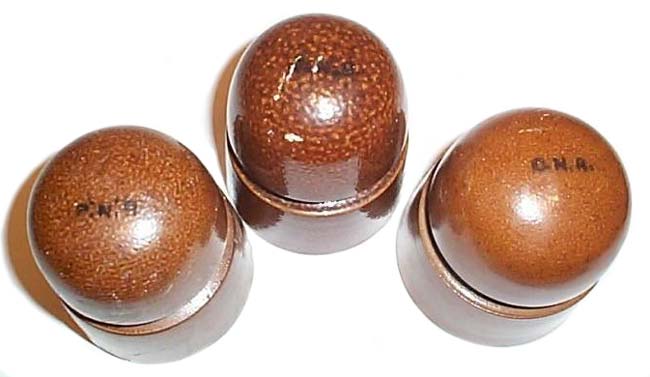
Examples of the CNR embossings and glazes.
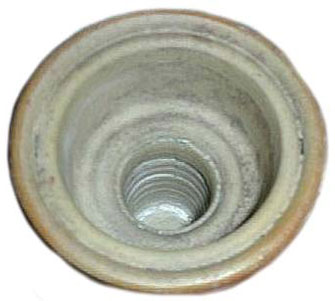
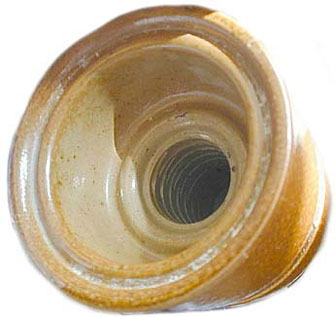
Bottom views of CNR embossed beehives. The left insulator has no glazing inside
the skirt while the right insulator is completely glazed. If you look closely at
the pinhole on the right insulator, you can see the start and stop of each ring.
With this hand made threading, it’s possible that some insulators were made threadless. Given that the CNR marked insulators have been found grouped around a pole or two and under station platforms, the threadless versions would have a better chance of being used. The ringed CNRs are impossible to thread on common threaded pins. Maybe they would have worked better on a threadless pin? Perhaps these were made as a possible replacement for threadless insulators? Threadless insulators were still in the air in the early 1900s, even as late as the 1950s in some places. If a threadless popped off a pin (As they were known to do.), these ringed porcelain insulators might have been designed as a replacement that would save the need to replace the insulator pin as well as the insulator. The concept must not have worked, as there are very few around. I’ll speculate that there is up to a couple of dozen CNR marked “dinosaur eggs” in various collections. The hobby will not likely ever know the origin or design thoughts behind these interesting porcelain beehives that have only been found in Canada. As Manfred wrote, you never know what’ll turn up with the next lead.
First Annual South Western Ontario Swap
and Show
by Barrett Nicpon
The First Annual South Western Ontario Swap & Sale was held at the Nicpon residence in the small town of Mount Brydges Ont., just south west of London. Picture, if you will, the most beautiful day you have ever seen. The sky is bright, blue, & lightly streaked with puffy, cute, almost surreal & cartoony clouds, and you feel on top of the world! So were the circumstances of the show day. What more could we ask for an outdoor meet?
The show officially opened to collectors at straight noon, but there were collectors showing up to talk glass, meet with old collecting friends, or just set up their goods, and to be ready for trading as early as 10. Trading or buying before noon was a no-no, though, and many an attendee were caught red handed reaching for their wallets. You know who you are.
The first collector to drive up, & the one most dedicated to the cause of the insulator show, was Tom Iannelli, one of two show co-hosts, who pulled into the driveway around quarter to 10 AM. As more & more collectors began to show up. Henry & Hilary Nicpon, the owners of the property on which the show was held, found more ways to help out than were originally thought possible. Henry directed traffic to make parking and set up more convenient for everyone, while Hilary prepared a feast worthy of royalty, but made available to everyone ordinary, and out of the ordinary, that showed up. On the menu were hamburgers, sausages, all manor of salads, produce, fruits, and baking products.
As I was helping Kyle Waters, the first collector to be there (remember: we are teenagers, and sleep overs are a part of our regular schedules), re arrange picnic tables, collectors started pouring in. Included among the attendees were, in no particular order; Phil Ort, Chris Minicola, Mike Csorbay & Debbie Kinloch, Paul Axman, The Banks Brothers, Manfred Hagar, Shawn Long, The Wessel & Belanger families, Kevin Kidd, and many other visitors from outside the visible spectrum of collectors in the hobby! Matt Kancle came all the way from Pennsylvania to attend the swap, as well as Patrick Young, his son Mackenzie, and Mark Bauer who took the time to drive up from Michigan.
The glass which arrived was not just your characteristic common backyard swap glass, either, as some bee-ou-tee-ful pieces in the quadruple digit value range showed up. Some interesting walk-ins were, a cobalt CD 718, a beautifully under poured 740.4, a bright sapphirish CD 742 M.T.Co. Tables featured a large variety of early Canadian glass such as double threaded & threaded threadless CD 143 variations, CD 743s, and all manor of sadly broken scarce & beautiful pieces. And, of course, all the other good glass, AND porcelain!
Aside from the insulators, though, it was great to be able to meet some new faces, and shake hands with familiar ones. I don't believe I can complain about the weather, the turnout, the food, or anything else. I'd say the show went over extremely well. And keep in mind, everyone, the ads did say "First Annual"! I hope to see everyone back, or coming for the first time, next year at the Second Annual Southwestern Ontario Insulator Swap & Show! Until then, though, good luck on the lines!"
Barrett
This column’s header insulator is a CD 143 no name Withycombe which can be found in light green or grayish light purple. Photo credit and thanks goes to Dwayne Anthony of California.
As always, feel free to contact me with comments, contributions or topics you might like to see covered in future Canadian Forum columns.
Good Collecting ............. Robin
Robin Plewes, Almonte Ontario, Canada.
Phone: 613-256-7638 or Email: highdome@gmail.com
 Return to the Canadian Forum
Return to the Canadian Forum